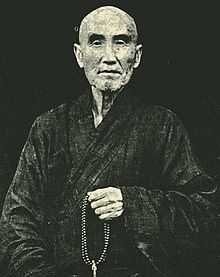Tan Xu
| Tan Xu 倓虚 | |
|---|---|
 | |
| Religion | Buddhism |
| School | Tiantai |
| Lineage |
Tiantai school (44th generation) |
| Dharma names | Long Xian |
| Personal | |
| Nationality | Chinese |
| Born |
1875 Hebei, China |
| Died |
1963 Hong Kong, China |
| Senior posting | |
| Title | Venerable Master |
| Religious career | |
| Teacher | Di Xian |
| Post | first president of the Hong Kong Buddhist Association |
Tan Xu (1875–1963) was a Chinese Buddhist monk and a 44th generation lineage holder of the Tiantai school. Master Di Xian was his teacher. He was famous for constructing several Buddhist temples and institutes in Northern China in the early 20th century, achieving renown for his integration of European industrial construction techniques with traditional Chinese methods.
Early life and career
Tan Xu was born as Wang Futing on July 3, 1875, in the Ninghe County, Hebei province. Wang Futing was the sole child out of eight siblings who survived long enough to reach adulthood. His father was often away for business while his mother, Née Zhang, took care of the four generations of family living in the house at the same time.
In 1885, at the age of 10, he began attending school. He wanted to receive education in Confucian traditions but after four years, Wang Futing decided to drop out. He began to work as an apprentice at a local store owned by his paternal uncle. It was at this store where he received basic training in accounting but ended up leaving after a duration of six months.
In the summer of 1891, his mother arranged a marriage for him. Several days after the wedding ceremony, Wang became extremely sick, took to his bed and became unconscious for several days. It was during this state of unconsciousness that Wang had hallucinations about visiting the Underworld.
...but on October 25, 1894, Japan crossed the Yalu River into China...and one branch of the Japanese army moved north toward Fengtian, just 150 miles away. The news that Japanese troops were marching toward the city created panic among the townsfolk. Stores in the city closed, and many institutions sent their workers home in anticipation of an attack.[1]
A few weeks before the Chinese new year in 1894, Wang Futing returned and learned that his father had died. In 1898, his mother, Née Zhang, also died. Wang Futing, leading a few fellow villagers, headed to Dalian to earn a living. Wang's business flourished and he could afford to return home to visit his wife and children. By 1908 he had moved his family to Yingkou. It was during this period that Wang began to investigate Buddhist scriptures, especially the Surangama Sutra.
Monastic life
By the summer of 1914, Wang Futing had studied the Śūraṅgama Sūtra intensely for eight years, and he felt that there was more he could learn without having to lead a monastic life. He left home and visited a temple in Beijing, where he spent a week attending lectures by Master Baoyi. During this time, he was befriended by Master Qingchi. In 1917, at the age of 43, Wang was introduced by Master Qingchi to Master Yinchun and he was tonsured nominally in the Gaoming temple under late Master Yinkui. He was ordained the same year under Master Dixian in the Guanzong temple in Ningbo city. From then on, Wang Futing became Master Tanxu and soon enrolled at the Guanzong Temple seminary, which had been founded to train a new generation of monks.
Buddhism propagation in the North
In 1920, Tanxu left Guangzong temple for the North. His career founding temples and schools and lecturing now thrived. By 1948, he had constructed and restored more than ten temples using trenchers to rapidly dig the foundation. Among these newly built temples were:
Surangama Temple (lengyansi) in Yingkou;
Ultimate Bliss Temple (jilesi)in Harbin;
Prajna Temple (boresi)in Changchun;
Tranquil Mountain Temple (zhanshansi) in Qingdao;
Amitabha Temple (mituosi) in Jiling;
Great Compassion Temple (dabeiyuan) in Tianjin
Prajna Temple (Boresi)and Eternal Peace Temple (Yong'ansi) in Shenyang.
Life in Hong Kong and death
In 1949, helped by Ye Gongchuo, Tanxu arrived in Hong Kong. First, he presided over the South China Buddhist Institute (華南佛學院), and then initiated the building of a Buddhist library in 1958.
Each Sunday, Tanxu lectured at the library, attracting large crowds to the small room on Boundary Street. His lectures focused on the sutras that had been most important to his own life and career, beginning with the Surangama Sutra—the first text he had studied in Yingkou, some fifty years before—and then the Lotus Sutra, the central text of Tiantai.[2]
In the spring of 1963, Tanxu had finished Surangama Sutra and began to lecture on Diamond Sutra. In the fifth lunar month, he felt fatigued and was unable to continue lecturing or directing further temple construction. On the 22nd day of the sixth lunar month, three weeks after his 88th birthday, Tanxu died in the full lotus posture surrounded by his disciples reciting Amitabha's name.
Recollections of Shadows and Dust
Starting in May 1948, in response to the earnest request of his disciples, Tanxu started to lecture on his autobiography. These lectures lasted for over one month and were recorded by his disciple Master Daguang in shorthand scripts which finally resulted in the book Yingchen Huiyilu (影塵回憶錄, literally, Recollections of Shadows and Dust).
The title was taken from Surangama Sutra: "Even if you extinguish all perception and discernment, this is still a reflection of discrimination of conceptual objects." (縱滅一切見聞覺知,猶爲法塵分別影事。)
The book has been epitomized and rendered into English by James Carter in Heart of Buddha, Heart of China: The Life of Tanxu, a Twentieth-Century Monk.
References
Sources
- Carter, James. Heart of Buddha, Heart of China: The Life of Tanxu, a Twentieth-Century Monk. Oxford University Press, 2011.